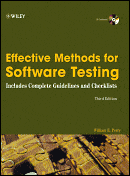Click on the cover to order from Amazon.com
ISBN: 0764598376
ISBN-13: 9780764598371
Format: Hardcover, 1008pp
Publisher: Wiley, John & Sons, Incorporated
For several years, I have recommended Bill Perry's Effective Methods for Software Testing, 2nd Ed to people who are looking for testing processes they can customize and apply quickly. I have also included this book as a reference text in many of my testing courses. Obviously, I feel that the book is very helpful to software testers.
In the third edition, there are two fewer chapters, but the coverage of topics has been revised to include areas such as agile testing, the role of testing in software development methodologies, testing internal controls, and an expanded discussion on security testing.
The eleven-step testing process in the second edition has been streamlined to seven steps in this edition. In this process, you will find everything you need to design and customize your own testing process all the way from test planning, through the various phases of testing (static testing, unit testing, integration testing, system testing and acceptance testing), and even through post-implementation testing. The process also addresses analyzing and reporting test results, which also discusses test metrics.
The reasons I'm such a fan of the book are:
1) You get complete templates and examples, including checklists (although the CD contains PDF versions of the forms which would still need to be re-created in a word processor to be usable in electronic format).
2) The book is process-oriented as opposed to a collection of techniques. Collections are fine, but you still need a way to apply them. That’s where the processes come in helpful. Also, the workbench process framework is helpful in defining your own processes.
3) These are practical and proven processes that have been used in a variety of organizations worldwide. There is very little theory and a lot of practical application as shown by the examples.
4) You don't have to be a highly mature organization to start applying these techniques. Whether you are CMMi Level 1 or 5, you can still find this information useful. 5)The book also addresses specific topics such as testing commercial-off-the-shelf software and data warehouse applications.
This is a thick book, but then again, it is not designed to be read from front to back. I use it as a desk reference and a collection of processes to help get the job of testing done. I can save hours of work in designing processes by checking here first. My attitude is to tailor the processes to meet my needs. It’s also my first stop when doing research.
Personally, I like processes because I can transfer them to others and have something tangible to study and improve. However, I will say that if you are "process averse" you will probably not find this book as helpful as someone who does process-based work. The processes described in the book are not heavy ones, though.
This is a good resource for software testers written by someone who has been writing and working in this profession for many years.
Readability - 4
Coverage of topics - 5
Depth of coverage - 5
Credibility - 5
Accuracy - 5
Relevance to software quality - 5
Overall - 5
Reviewed by Randy Rice


